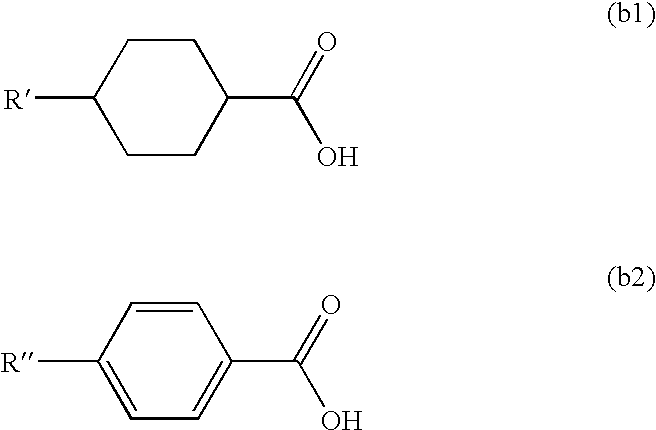Cholesteric liquid crystal composition
a liquid crystal composition and cholesteric acid technology, applied in the field of cholesteric acid liquid crystal composition, can solve the problems of difficult to isolate them by extraction for industrial use, disclosure or suggestion, and documents that do not disclose or suggest liquid crystallinity, and achieve the effect of low polymerization degr
- Summary
- Abstract
- Description
- Claims
- Application Information
AI Technical Summary
Benefits of technology
Problems solved by technology
Method used
Image
Examples
synthesis example 1
[0129](1) A mixture containing 50.0 g of a γ-oryzanol, available from Okayasu Shoten Co., Ltd., 30 g (0.45 mol) of potassium hydroxide (85%) and 500 mL of ethanol was stirred under heating and refluxing for 10 hours. Ethanol was distilled off from the mixture, which was then extracted with ethyl acetate, and the extract was washed with a saturated sodium hydrogen carbonate aqueous solution and then with water. The solution was dried over magnesium sulfate, and the solvent was distilled off to provide a hydrolysate of the γ-oryzanol as a brown solid.
[0130](2) 20 mL of thionyl chloride was added dropwise to a mixture containing 20.0 g (0.1 mol) of trans-4-pentylcyclohexanecarboxylic acid represented by the following formula (b-i), 0.5 mL of pyridine and 300 mL of toluene in a nitrogen atmosphere, and the mixture was stirred under heating to 80° C. or less for 1 hour. The solvent was distilled off under reduced pressure to provide trans-4-pentylcyclohexanecarboxylic acid chloride.
[0131...
synthesis example 2
[0132]The γ-oryzanol was hydrolyzed in the same manner as in Synthesis Example 1. Oleic acid represented by the following formula (b-ii) was chlorinated in the same manner as in Synthesis Example 1 to provide oleic acid chloride.
[0133]3.6 g (12 mmol) of the oleic acid chloride was added dropwise to a mixture containing 4.4 g (10 mmol) of the hydrolysate, 1.0 mL of pyridine and 50 mL of toluene at room temperature, followed by stirring at room temperature for 3 hours. After completing the reaction, an insoluble matter thus deposited was removed by filtration, and the filtrate was washed with water and dried over magnesium sulfate, followed by distilling off the solvent. The resulting residue was purified with column chromatography (silica gel chromatography, eluent:toluene / heptane (volume ratio: 3 / 2)) to provide 4.0 g of an esterified product (1-2).
synthesis example 3
[0134]The γ-oryzanol was hydrolyzed in the same manner as in Synthesis Example 1. A mixture containing 2.2 g (5 mmol) of the resulting hydrolysate, 20 mL of toluene, 5 mL of Solmix and 0.1 g of activated carbon supporting 5% of palladium (5% Pd / C) was then stirred in a hydrogen atmosphere at room temperature for 6 hours. After completing the reaction, the activated carbon supporting palladium was removed by filtration, and the filtrate was washed with water and dried over magnesium sulfate, followed by distilling off the solvent, to provide a hydrogenated product of the hydrolysate of the γ-oryzanol. 2.0 g of the hydrogenated product of the hydrolysate and 1.0 g of trans-4-pentylcyclohexanecarboxylic acid represented by the following formula (b-i) were subjected to esterification in the same manner under the same conditions as in Synthesis Example 1 to provide 1.8 g of an esterified product (2-1).
PUM
| Property | Measurement | Unit |
|---|---|---|
| temperature | aaaaa | aaaaa |
| temperature | aaaaa | aaaaa |
| temperature | aaaaa | aaaaa |
Abstract
Description
Claims
Application Information
 Login to View More
Login to View More - R&D
- Intellectual Property
- Life Sciences
- Materials
- Tech Scout
- Unparalleled Data Quality
- Higher Quality Content
- 60% Fewer Hallucinations
Browse by: Latest US Patents, China's latest patents, Technical Efficacy Thesaurus, Application Domain, Technology Topic, Popular Technical Reports.
© 2025 PatSnap. All rights reserved.Legal|Privacy policy|Modern Slavery Act Transparency Statement|Sitemap|About US| Contact US: help@patsnap.com



